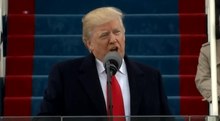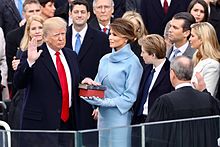Presidency of Donald Trump
Donald Trump's presidency, the four-year term of the 45th President of the United States, began on January 20, 2017 with the inauguration of Donald Trump and ended on January 20, 2021 with that of his successor Joe Biden. It was under the self-imposed motto "America First" and, according to Trump's platform, featured elements of populism, isolationism, and protectionism. His political style, characterised as Trumpism, deepened the divisions in US society and intensified the antagonisms between Republicans and Democrats.
The 2016 election campaign was already highly polarizing. Republican Trump won - surprisingly in the eyes of most observers - against Democrat Hillary Clinton, securing the Electoral College majority but not the electoral vote. Throughout his tenure, Trump's relationship with policymakers and with the media, which has given him extraordinary coverage, has been considered strained. His confrontational and provocative language and style have been the subject of much debate since. Protests against him began even before he took office and became more entrenched as his term progressed. Doubts about Trump's fitness for office were raised in three areas in particular: On issues of his competence and his psychiatric and neurological health. Trump became the only president in the history of the United States to face two impeachment hearings. His anti-establishment presidency has been interpreted in American political history as an expression of a change in the party system, but also as a throwback to the "imperial presidency" of Richard Nixon. Trump's support by the so-called "silent majority" is also seen as a counter-movement to the previous presidency of the African-American Barack Obama.
Trump began campaigning for the 2020 presidential election immediately after taking office. Although he managed to win even more votes in 2020 than in 2016, his re-election failed because his policies, perceived as confrontational, erratic and - especially during the Corona pandemic - inadequate, mobilised opposing forces to an even greater extent. As a result, his Democratic rival Joe Biden was able to garner about 7 million more electoral votes and a majority of the electoral college.
Inauguration
→ Main article: Donald Trump's inauguration
Inauguration ceremonies began in Washington on January 17, 2017. The actual inauguration as the new U.S. president took place after the presidential transition on January 20, 2017, on the West Front of the Capitol in Washington, D.C. In his 16-minute inaugural address, Trump said, among other things:
"From today on, it's just 'America First.' [...]
Together, we will make America strong again. We will make America prosperous again. We will make America proud again. We will make America safe again.
America will start winning again - winning like never before.
We will bring back our jobs. We're going to take back our borders. We will bring back our prosperity. And we're going to bring back our dreams. We will build new roads and highways and bridges and airports and tunnels and rail lines across our wonderful country.
We will abide by two simple rules: Buy American, hire American. We will seek friendship and goodwill
with the nations of the world, but we will do so with the understanding that it is the right of all nations to put their own interests first."
First lady Melania Trump stayed in New York with her son Barron until the end of the school year, moving into the White House on June 11, 2017.
On the day of his inauguration, Trump filed paperwork to participate in the upcoming 2020 election with the Federal Election Administration, earlier than any previous incumbent. This allowed Trump to fundraise from the beginning of his presidency, which continued to consist primarily of small sums from individual donors and was spent on merchandising (such as the red Make America Great Again caps) and on renting office space owned by the Trump Organization. Just four weeks after taking office, Trump held his first campaign event.

Play media file Trump's January 20, 2017 inaugural address.

Donald Trump took his oath of office on the steps of the Capitol like his predecessor in office on the Lincoln Bible (as well as his own children's Bible)
Personal
During the first year of the presidency, according to an analysis by the Brookings Institution, 21 of the 61 leaders appointed by Trump left their positions again, a proportion of 34 percent. That was the highest proportion ever in the analyzed first years of U.S. presidencies over the past 40 years, twice the second-highest proportion (1981 in the first year of Ronald Reagan's presidency). In the first year of Trump's presidency, more than a hundred employees left the Environmental Protection Agency and the State Department, while hundreds of top federal positions went unfilled. The lack of expertise contributed, among other things, to the humanitarian crisis following hurricane damage in Puerto Rico. Chuck Todd analyzed in March 2018 that Trump's staff picks increasingly showed he was surrounding himself with people who publicly sought tough confrontation, were experienced in television appearances and who did not disagree with his views. Trump often humiliates those he fires, for example by making the decision public via tweets.
As of January 4, 2021, 540 of the 757 positions requiring Senate confirmation have been filled. There were no nominations for 214 positions. In 166 cases, the confirmed person resigned from office.
Consultants and staff functions
Trump appointed Stephen Bannon as a top adviser shortly after the election, which caused debate; Bannon was the owner of the alt-right internet platform Breitbart News Network until August 2016. In August 2017, Bannon, who has always remained controversial, left the White House. Kellyanne Conway, who had managed Trump's campaign, advised the president in the White House primarily on communicating his policies to the public. Press secretary until July 2017 was Sean Spicer, who had been spokesman for the Republican National Committee since 2011. He was succeeded by Sarah Huckabee Sanders; White House communications director Anthony Scaramucci became for ten days in July 2017, to great fanfare. In his short tenure, Scaramucci oversaw the replacement of former Chief of Staff Reince Priebus, who was replaced in July 2017 by former general and former Secretary of Homeland Security John F. Kelly.
In late December 2016, Trump named his longtime lawyer and confidant Jason Greenblatt, co-chair of the Trump Organization, as "special envoy for international negotiations." He appointed Jerry Falwell Jr, an exponent of the Christian Right and creationism, to head a task force on education reform in late January 2017.
Former Republican senator and ambassador to Germany Dan Coats succeeded national intelligence chief James Clapper, and CIA vice president Gina Haspel, who had presided over a US secret prison in Thailand under George W. Bush, became CIA vice president.
Trump's daughter Ivanka became Assistant to the President ("Presidential Assistant" without pay) at the end of March 2017 and was given her own office in the White House. She takes care of "softer" issues such as women, equality and health. Her husband, Jared Kushner, was appointed by Trump as chief advisor ("senior advisor") along with his speechwriter Stephen Miller. In addition, Kushner was given special assignments such as Middle East mediator and head of the White House Office of American Innovation.
Trump created advisory bodies such as the Technology Council, the Strategic and Policy Forum, and the American Manufacturing Council. He dissolved the latter two in August 2017 after prominent members such as Travis Kalanick, Elon Musk, and Kenneth Frazier resigned in protest of his immigration ban, climate policy, and reaction to the far-right rally in Charlottesville. Another advisory body - installed by President Ronald Reagan in 1982 - the President's Committee on the Arts and the Humanities, which included numerous Hollywood actors and artists such as Kal Penn and Jhumpa Lahiri, resigned en masse in mid-August 2017.
Cabinet
→ Main article: Trump cabinet
Trump's cabinet includes many political newcomers and career changers, including some business leaders and generals, who together have between ten and fifteen billion US dollars in private wealth. That is more than a third of all American households have at their disposal, and thirty times that of the George W. Bush cabinet.
Trump was keen to break the rules, as the German journalist Christoph von Marschall put it: he nominated Andrew Puzder, the head of the fast-food chains Hardee's and Carl's Jr. , as Secretary of Labor - against the unwritten rule that Democrats do not appoint a union leader and Republicans do not appoint a corporate CEO as Secretary of Labor. Puzder withdrew his candidacy because of numerous pending lawsuits against his companies. Trump's Commerce Secretary Wilbur Ross was previously an investor specializing in the recovery of troubled companies. Treasury Secretary Steven Mnuchin, previously a hedge fund manager, was criticized for his harsh treatment of homeowners. Mnuchin, Ross were, Trump's chief strategist Bannon and other staff members previously worked for investment bank Goldman Sachs. Trump's cabinet has seen an unusual number of ministerial changes and an unusually high proportion of acting cabinet members (see here).
Trump filled three key positions in his cabinet with climate protection opponents and representatives of the oil industry (see climate change denial), namely the Secretary of Energy Rick Perry, the head of the Environmental Protection Agency (EPA) Scott Pruitt and the Secretary of State Rex Tillerson, who had previously been the head of the oil company ExxonMobil.
.jpg)
Trump, James N. Mattis and Mike Pence, January 2017.
Questions and Answers
Q: When did the presidency of Donald Trump begin?
A: The presidency of Donald Trump began at noon EST on January 20, 2017.
Q: What was Donald Trump's position before becoming President?
A: Before becoming President, Donald Trump was a member of the Republican Party.
Q: Who did Donald Trump succeed as President of the United States?
A: Donald Trump succeeded Barack Obama as President of the United States.
Q: What number President is Donald Trump?
A: Donald Trump is the 45th President of the United States.
Q: When was Donald Trump inaugurated?
A: Donald Trump was inaugurated as President on January 20, 2017.
Q: What time was Donald Trump inaugurated?
A: Donald Trump was inaugurated at noon EST on January 20, 2017.
Q: Which political party is Donald Trump a member of?
A: Donald Trump is a member of the Republican Party.
Search within the encyclopedia